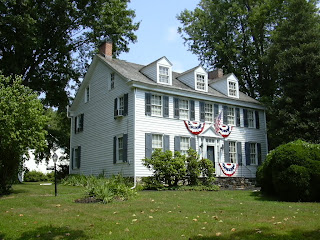 |
| The Meeteer House |
In the 1780's, a Quaker from Chester County named Thomas Meeteer moved to Delaware and established a paper mill along the banks of White Clay Creek. Known as the Milford Paper Mill, it was one of the largest operations in MCH, employing over 50 workers by 1820. When Thomas died in 1812, his sons William (1776-1838) and Samuel (1787-1833) took over the family businesses. William assumed control of a family-owned bookstore in Baltimore, and Samuel remained here to run the mill. In 1816, Samuel and William purchased a 152-acre tract from Joseph and Eliza England that included a log dwelling. According to county tax assessments, sometime between 1822 and 1828 the Meeteers replaced that lone log house with a much larger frame house -- the Meeteer House that stands today.
While the home is still considered to be of a respectable size today, for its time, it was downright grand. In 1828, Samuel and William Meeteer were the second largest, and second wealthiest, landowners in Mill Creek Hundred. Their home was likely one of the biggest in the area when it was built. In addition to its size, its presence today is remarkable for one other reason -- its construction. At the time it was built, stone, brick, and log houses greatly outnumbered frame ones. In fact, there were only 36 frame-built houses in MCH in 1828. Not only has this house survived for almost 200 years thanks to the wonderful care given it by its owners, but it has survived almost completely intact. For a very in-depth description of the construct, layout, and state of the Meeteer House, check out its National Register of Historic Places registration form.
And just in case you haven't figured out the connection between the Meeteer House and that "significant, and recently lost, piece of Newark-area history", the Meeteer's Milford Mill was eventually sold in 1847 to George and Soloman Curtis, under whose ownership it was renamed the "Curtis Paper Mill". Later in the 19th Century the old mill was torn down and replaced with a larger, newer mill, also recently razed in its seat at the base of Paper Mill Road on the edge of Newark.
Of you know that this was where I was born so yes it belonged to Guenveur’s at one time I believe it had a Poch I sent Yaskic a picture of it
ReplyDeleteYes, it did come up in the post about the house on Old Capitol Trail near St. James Church that the Guenveurs also owned. This is another of those sites that I should get back to at some point, since I can find much more info now than when I first wrote about it.
Delete